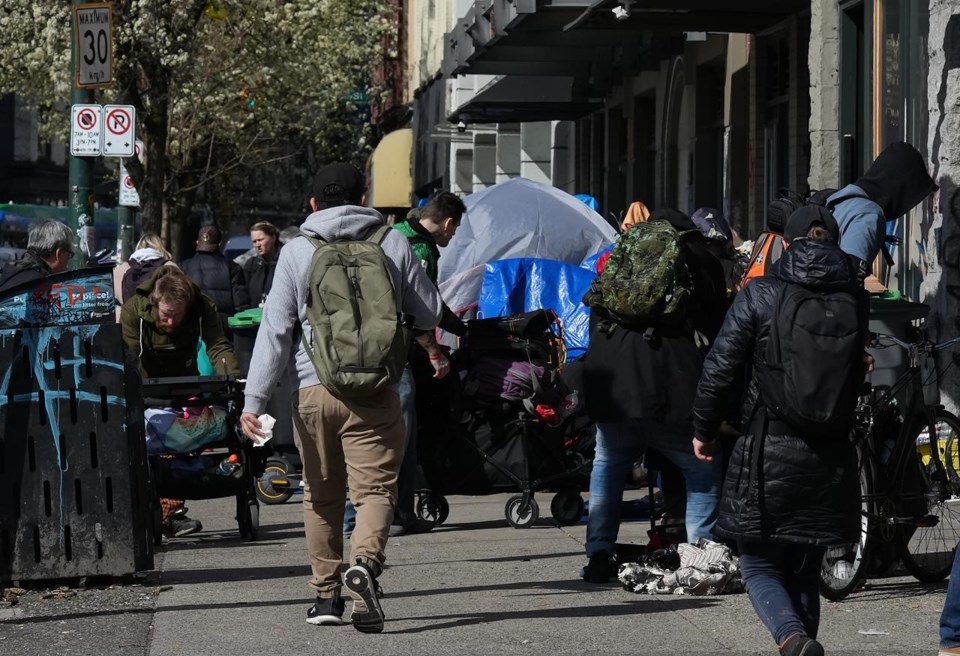VANCOUVER — On Christmas Day, Trey Helten and colleagues at Vancouver's Overdose Prevention Society were still at work, dealing with the latest victim of what Helten says is a seasonal spike in the drug toxicity crisis.
Helten shared a photo and a story on social media on Monday describing how he and colleagues administered Naloxone to a man who had overdosed and stopped breathing on Vancouver’s Downtown Eastside.
“At a time of the year when it's supposed to be family togetherness, you lose someone that you care about. It can be extremely devastating,” said Helten in an interview.
“So, the reason I posted it was just to bring awareness to it. It wasn't to be exploitive or anything … at least we prevented one family from getting a call that their loved one is deceased,” he added.
Helten's photo, shared on the social media platform X, formerly known as Twitter, shows a man lying on the street and being tended to.
A plastic bag decorated with Santa Claus logos, that Helten said contained the man's belongings, is torn open on the ground.
Helten said the overdose prevention society runs several tents across Vancouver's Downtown Eastside neighbourhood, including one on East Hastings Street.
He said that around noon on Christmas Day, staff noticed a man on the corner “slumped over and purple,” indicating a lack of oxygen.
Helten said they gave him shots of Naloxone. “Thankfully, he still had a pulse and we started giving him oxygen and he started vomiting,” Helten said.
He said Vancouver Fire Rescue Services and BC Ambulance Service paramedics arrived and took over caring for the man.
“The last thing he remembered was taking a hit of crack cocaine or what he thought was crack cocaine … But it turns out it was fentanyl, he turned blue and overdosed,” said Helten.
Brian Twaites, a paramedic public information officer with BC Emergency Health Services, said two ambulance crews responded at Hastings Street after receiving a call at noon on Christmas Day.
Twaites said paramedics cared for one patient who was taken to hospital.
Vancouver Fire Rescue Services Acting Assistant Chief of Operations Geoff Clark said crews responded to multiple overdose incidents in the Downtown Eastside on Christmas Day.
Helten said the incident highlighted a “reoccurring” issue, in which the toxic drug supply combines with the holiday season in a destructive fashion.
“Christmas is a really hard time for a lot of people and maybe some people are sad and they want to use drugs to deal with trauma and it can lead to an overdose,” said Helten.
The BC Coroners Service has also warned of a seasonal increase in overdoses.
The service issued a statement in mid-December about the apparent spike, saying the province had averaged about seven deaths per day in recent weeks.
"Unregulated drug deaths in the winter months have historically increased over the numbers reported during the rest of the year, so this early increase could be a sign of another challenging season for people who use drugs in B.C.," it said in a news release.
In an update issued at the end of last month, the service said unregulated drugs had claimed at least 2,039 lives in the first 10 months of the year.
It said at least 13,317 people had died due to unregulated drugs in B.C. since a public-health emergency was declared in April 2016.
The service said unregulated drug toxicity was the leading cause of death in B.C. for people aged 10 to 59, accounting for more deaths than homicides, accidents and natural disasters combined.
Helten said the numbers have been reflected in the community he loves.
“I look around on the Downtown Eastside and I just see the dwindling community. Every year it gets smaller and smaller and smaller and less people around,” said Helten.
This report by The Canadian Press was first published Dec. 27, 2023.
Nono Shen, The Canadian Press



